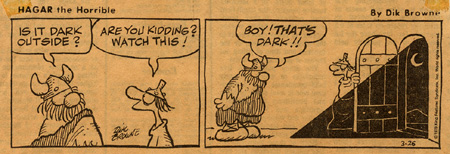

Jeremy, promoter of fundamentally fine physics, proudly presents:
Measuring the Speed of Light in the Second
Year Physics Lab
by David Mar, nearly PhD, School of Physics, University of Sydney, Australia
Many people (mostly second year students) think that the second year lab is a waste of time. Well, to quash these ugly rumours once and for all, we present an ingenious new method for measuring the
speed of light with high accuracy, using no more equipment than that easily found lying around the lab.
Have you ever noticed that when you switch off a laser, there is a noticeable time delay before the spot of light actually disappears? Utilising this important observation, a laser was set up to project a beam of light down the length of the lab, and the time delay between switching the laser off and the disappearance of the red spot on the front wall was measured with a stopwatch.
Ten observations of this time were made, shown below:
0.38 s 0.53 s 0.44 s 0.34 s 0.37 s
0.38 s 0.37 s 0.37 s 0.47 s 0.41 s
The mean time and standard error of the mean from these readings was 0.41 +/- 0.01 s, but since the readings of 0.53 s, 0.44 s, and 0.47 s are clearly anomalous [This is a great word to use when describing data you don't like.] , they were discarded. The mean of the remaining seven readings was 0.374 +/- 0.001 s, which is clearly a better result since the uncertainty is so much lower [Always a good justification for throwing away dodgy data.]
The distance from the exit aperture of the laser to the diffuse reflecting planar surface upon which the coherent light beam was observed [The front wall of the lab.] was carefully measured [With the "end to end" technique using two wooden metre rules.] and found to be 18.49 +/- 0.01 m.
Applying careful thought to the peculiarities of the chosen geometry, it was realised that the photons of the light beam were actually travelling twice this distance---to the front wall and then back again to the eye after reflection. The total distance travelled by the light is therefore 36.98 +/- 0.02 m.
Dividing the distance travelled by the observed time lag, the deduced speed is 98.9 +/- 0.3 m/s . Thoughtful readers will have realised already that this is not actually the speed of light, per se, but the speed of dark, as the observations were made of the time lag between turning the laser off and observing the arrival of the dark at the front wall.
However, it can easily be shown by symmetry arguments that the speed of dark is related to the speed of light by
c = 3*pi*c_dark / 8*alpha^3
where
alpha = e^2 * 4*pi*hbar /
Sqrt(epsilon_0*mu_0)
which equals 7.29735E-3,is the dimensionless atomic fine structure constant.
Performing the calculation, the resultant speed of light from this experiment is (2.998 +/- 0.009)*10^8 m/s , which is consistent with the accepted value of 2.99792*10^8 m/s. In fact, the agreement is good to the fifth significant figure, indicating that the uncertainty estimates used throughout the experiment were somewhat conservative.
Back to Jeremy
Last updated: 7th February, 1995
University Of Sydney Physics Society
physoc@physics.usyd.edu.au